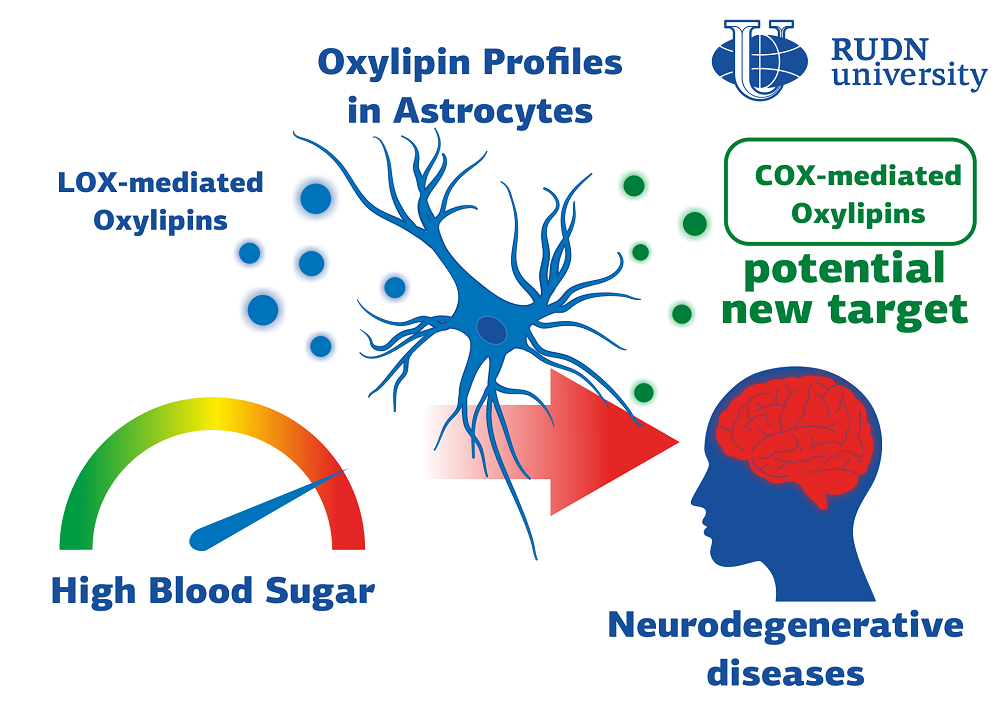Chemist Finds New Target For the Treatment of Neurodegenerative Consequences of High Blood Sugar
High blood sugar (hyperglycemia) can cause cognitive impairment, epilepsy and other neurodegenerative disorders. The main form of glucose storage in the body is glycogen. In the brain, it is stored mainly in nerve cells, astrocytes, which are formed from various polyunsaturated fatty acids. They “communicate” with each other, releasing signalling molecules — oxylipins. Until now, it was not known what happens to oxylipins when glucose levels increase. Chemists from the RUDN University and MSU have studied how hyperglycemia affects oxylipins and proposed a new therapeutic target for the treatment of brain disorders associated with hyperglycemia.
“Hyperglycemia is associated with several complications in the brain. igh glucose exposure causes astrocyte dysregulation, but its effects on the metabolism of oxylipins are relatively unknown and therefore, constituted the focus of our work”, said Sergey Goriainov, the Head of the Laboratory of Mass Spectrometry and High-resolution NMR Spectroscopy of RUDN’s Center for Collective Use.
To compare how the oxylipin profiles in the astrocytes change with different glucose levels, scientists took astrocytes from the brain of rats and placed them in an environment with normal (5.5 mmol) and high (25 mmol) glucose concentration. The biochemists then measured the profile of oxylipins using a high-performance liquid chromatography-mass spectrometer UPLC-MS/MS. Oxylipins were divided into two groups, depending on by which enzymes they were derived from their predecessors — polyunsaturated fatty acids. Then they statistically analyzed the data.
It turned out that with high glucose, the profile of oxylipins released by astrocytes changes. In an environment with a high concentration of glucose, there were about four times more oxylipins, which were obtained by cyclooxygenase (COX). At normal sugar levels, COX-oxylipins were about five picograms per milligram, and about 20at high levels. For comparison, the level of oxylipins, derived by another enzyme (lipoxygenase, LOX), hardly changed depending on the glucose level and remained at 1-3 picograms per milligram. Scientists have concluded that COX-oxylipins may become a new direction for the treatment of brain disorders that occur due to hyperglycemia.
“The data suppose a regulation of COX-mediated oxylipin synthesis as a potential new target in the treatment of brain impairment associated with hyperglycemia”, said Sergey Goriainov, the Head of the Laboratory of Mass Spectrometry and High-resolution NMR Spectroscopy of RUDN’s Center for Collective Use.
The results are published in Metabolites.
Sergey Ivanov, a scholar from St. Petersburg, has been named the first winner of RUDN University’s International Prize for Scientific Achievements in Mathematics, worth 5 million rubles.
Products derived from microalgae represent a cutting-edge development in the field of bioeconomy. The potential of this biological resource was discussed at the international research seminar “Foundations for a Green Sustainable Energy”, part of the BRICS Network University’s thematic group on “Energy”. The event was organized by the Institute of Ecology at RUDN University.
Ambassadors of Russian education and science met at a conference in RUDN University to discuss how they can increase the visibility of Russian universities and research organizations in the world, and attract more international students in Russia.
